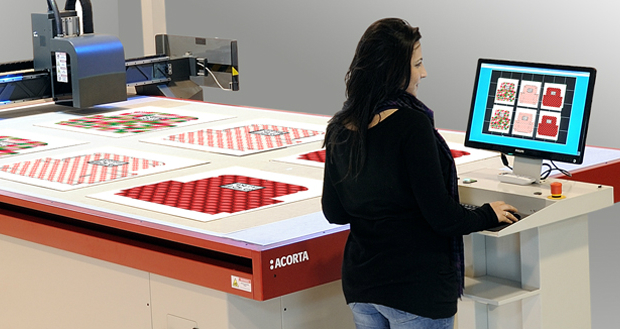The imaging giant also launched two new plates; the Amigo TS and the Azura V violet processless. In addition a new version of Apogee workflow hit the floor, version 7.0, which comes with integrated imposition software.
Steve Taylor, inkjet manager at Agfa Oceania says, “Agfa now has a complete range of inkjet solutions. The Jeti range comprises flatbed and roll to roll, UV and solvent. It will appeal to commercial printers, screen printers and signage printers.”
Taylor says Agfa’s strategy of selling direct is a major advantage, as is the brand, and the infrastructure.
Agfa says the new :Jeti system features photo realistic quality, grayscale printing up to 110 m2/hr printing speed and industrial grade construction. The company claims it offers the widest colour gamut and highest productivity in its class. Built on a steel platform, designed for three shift operations, it features a linear motor driven vacuum bed for dot placement in both flat bed mode or with an optional roll-to-roll. The flatbed can print up to five cm thick and can support media rolls up to 110 kg.
The :Jeti 1224 UV HDC is the first Jeti printer to use the Ricoh Gen 4 variable grayscale print head technology. Agfa has introduced new ink technology to drive the Ricoh heads up to 30 KHz in binary and 13KHz in grayscale. With 4 colour and white as standard, Agfa says the printer delivers equivalent speeds in both binary and grayscale modes at resolutions up to 1200 dpi. It rates throughput at 110 m2/hr in express mode, 54 m2/hr in production mode, and 36.2 m2/hr in high quality mode. Agfa says the printer consumes less than 7.6ml of ink per m2 yielding over 140 m2 per litre of ink, and adds the printer is suited for high resolution trade show graphics, point of sale displays, real estate signs, backlit signs, lenticular displays, high resolution banners and ceramic tiles.
Agfa says its new :Azura V chemistry-free plate for violet CtP systems works with all mainstream violet CtP units currently in use and emitting at least 30 mW and adds that it can run in virtually all existing photopolymer processors on the market, but no traditional photopolymer developer is required. The plate works with a clean-out unit or an adapted existing plate processor. It uses a new photopolymer emulsion that works with a pH neutral cleanout gum and provides run lengths up to 100,000, according to Agfa.
Agfa claims its new :Amigo TS plate is up to 50 percent faster, offers improved contrast and runs in standard plate production equipment. The company says the :Amigo TS has improved image contrast with a run length of up to 200,000 plus impressions without post baking; and can be baked for longer runs. It adds that imaging and processing of the plate is compatible with most platesetters and processors in the market.
Comment below to have your say on this story.
If you have a news story or tip-off, get in touch at editorial@sprinter.com.au.
Sign up to the Sprinter newsletter

